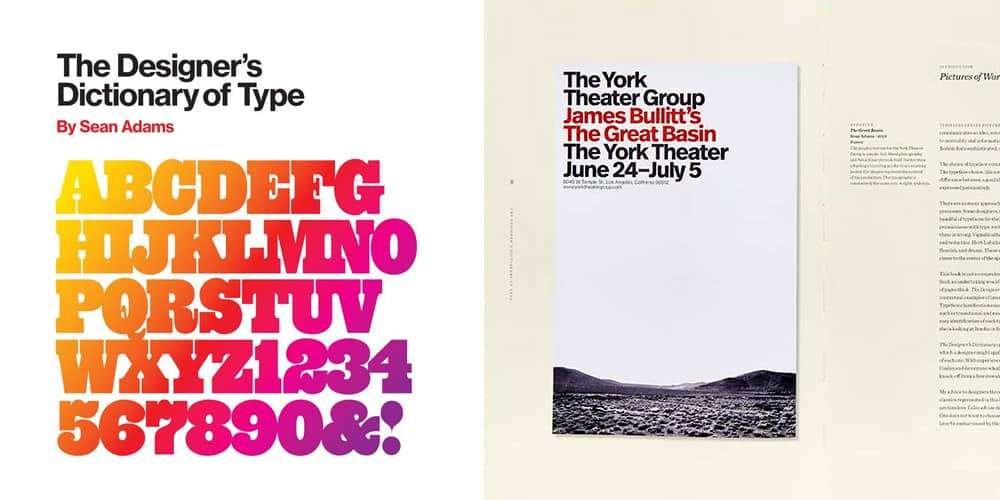The Designer’s Dictionary of Type follows in the footsteps of The Designer’s Dictionary of Color, providing a vivid and highly accessible look at an even more important graphic design ingredient: Typography. From classic fonts like Garamond and Helvetica to modern-day digital fonts like OCR-A and Keedy Sans, author and designer Sean Adams demystifies 48 major typefaces, describing their history, stylistic traits, and common application.
Unlocking the World of Typography: The Designer’s Dictionary of Type
Typography is a silent yet influential art form that plays a crucial role in graphic design, affecting the visual appeal and readability of various materials, from websites to printed content. Sean Adams, a accomplished designer and co-founder of the renowned design firm Adams Norioka, takes readers on an engaging journey through the intricate world of typefaces in his book “The Designer’s Dictionary of Type.” This book serves as a follow-up to Adams’ successful “The Designer’s Dictionary of Color,” and it provides an in-depth exploration of 48 major typefaces, covering their history, styles, and applications. The book offers a comprehensive guide that demystifies these fonts, making it an indispensable resource for designers, educators, and students seeking to build a strong foundation in the art, practice, and evolution of typography.
Delve into the Rich History of Typography
The history of typography is rich and has a storied past, and “The Designer’s Dictionary of Type” allows readers to delve into its evolution, from ancient scripts to modern digital fonts. The book is carefully organized into categories, including serif, sans-serif, script, display, and digital typefaces, providing a systematic approach to understanding the characteristics of each typeface. By examining the origins and design elements of fonts like Garamond, Helvetica, OCR-A, and Keedy Sans, Adams offers insights into how typefaces have transformed and continue to influence contemporary design.
In addition to the detailed entries on individual typefaces, the book also features a glossary of typographic terms, a list of resources for further study, and an index.
Benefits to Readers
- Gain a deeper understanding of the art, practice, and history of typography
- Learn about the stylistic traits and common applications of major typefaces
- Develop the skills to make informed decisions about typographic choices
- Find inspiration for their own typographic work
- Enhance their knowledge of typography
Audience
- Designers
- Typographers
- Students of design
- Anyone interested in typography
A Visual Feast of Typography
What sets “The Designer’s Dictionary of Type” apart is Adams’ unique ability to bring the world of typefaces to life through visually stunning examples. These illustrations showcase the artistry and expressiveness of typography as harnessed by some of the world’s most renowned designers. These real-world applications help readers grasp how typography can be both a functional tool and a work of art.
Meet the Author: Sean Adams
Sean Adams is not only an author, but also a prominent figure in the design world. As a founding partner of Adams Norioka, an award-winning design firm that is widely regarded as one of the industry’s most influential, Adams has been instrumental in shaping the design landscape. He has been recognized as one of the 40 most important people shaping design on a global scale and has served as the AIGA national president. His influence extends beyond traditional mediums, as he is also a respected on-screen author for lynda.com/LinkedIn.
Adams’ exceptional contributions have been recognized with numerous honors, including the prestigious AIGA Medal in 2014, which is the highest accolade in the design profession. He has also been named an esteemed AIGA Fellow and an Aspen Design Fellow. Adams’ work has received widespread recognition from prestigious competitions and publications such as How, Print, Step, Communication Arts, Graphis, The Type Directors Club, and the Art Director’s Club. His talents have been showcased through numerous exhibitions, including a solo exhibition at The San Francisco Museum of Modern Art.
Unleash the Power of Typography with “The Designer’s Dictionary of Type”
Sean Adams, with his insightful magazine columns and highly successful books, has established himself as a prominent figure in the field of design. He is widely recognized as one of the most influential individuals shaping the industry globally, as well as one of the top ten influential designers in the United States. Adams has an impressive track record, having previously been a founding partner at Adams Morioka, where he worked with high-profile clients such as The Academy of Motion Picture Arts and Sciences, Disney, Mohawk Fine Papers, The Metropolitan Opera, Los Angeles County Museum of Natural History, Richard Meier & Partners, Sundance, and the University of Southern California.
Conclusion
“The Designer’s Dictionary of Type” is an essential guide for anyone passionate about graphic design and typography. Written by Sean Adams, this comprehensive reference book is a treasure trove of information on the art of typography, providing readers with a thorough understanding of typefaces, their historical context, and visual examples. This book is an invaluable resource for designers, educators, and students alike, offering insights and inspiration to navigate the complex world of typography. Whether you’re a seasoned professional or just starting out, “The Designer’s Dictionary of Type” will help you enhance your design journey and deepen your appreciation for the power of type. With its clear and engaging writing style, this book is a must-read for anyone seeking to unlock the secrets of typography and improve their design skills.
The Designer’s Dictionary of Type by Sean Adams. Hardcover: 256 pages. Publisher: Harry N. Abrams (April 2, 2019).
Thank you for taking the time to read this article that we’ve carefully put together for our readers. We want you to be aware that there are affiliate links in this article. This means that if you buy something through these links, we may earn a commission. We appreciate your support as it helps us keep producing high-quality content. Rest assured that our recommendations are always honest and unbiased.





